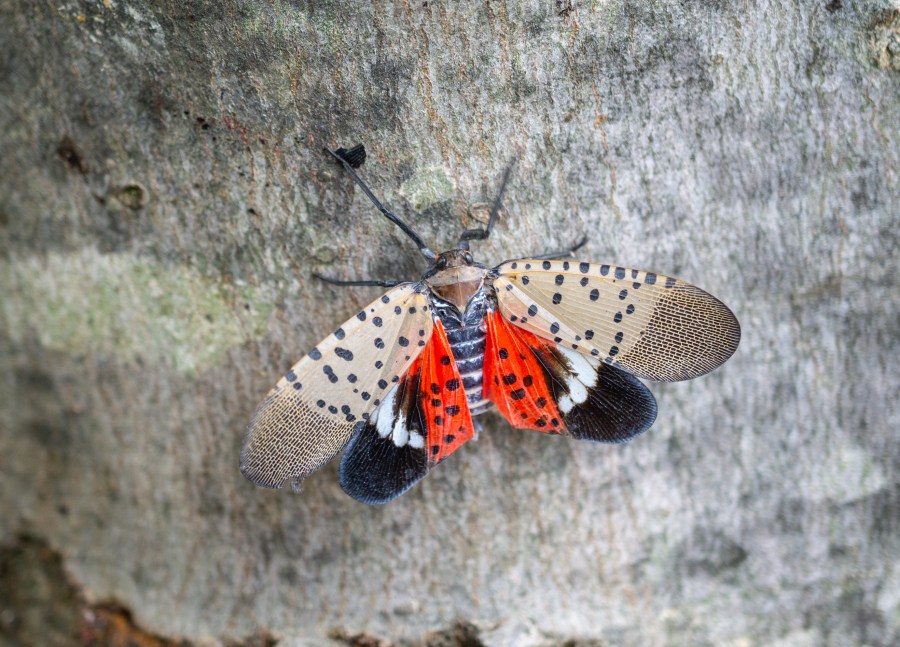It may look stunning, but officials want you to kill this bug if you see it

A mature spotted lanternfly found in Chester County, Pennsylvania. The bug is in this stage between July and December. (Getty)
(NEXSTAR) – Measuring about one inch in size, the spotted lanternfly, with its spots and pair of bright red wings, may be a stunning sight for some. For others, it’s a cause for serious concern.
Officials in New York warned about the invasive bug on Monday, saying it could impact the state’s grape and wine industries. The Pennsylvania Department of Agriculture recently encouraged residents to check their cars for lanternflies hoping to hitchhike to new areas.
Since first being detected in the U.S. in 2014, the invasive bug has spread to 11 states, primarily across the Northeast. It was first found in Pennsylvania and has since been found in Connecticut, Delaware, Indiana, Maryland, Massachusetts, New Jersey, New York, Ohio, Virginia, and West Virginia.
A native to China, the spotted lanternfly feasts off of fruit, ornamental, and woody trees, especially the tree of heaven, a fellow invasive species native to China, according to the U.S. Department of Agriculture. Specifically, the spotted lanternfly feeds on sap from over 70 different plant species, PennState Extension explains. The damage left behind can cause the plant to stress, draining its health and potentially killing it.
Some states, like Pennsylvania, have enacted quarantines, which prohibit moving the bug at any life stage and regulate moving items the insect may live on like firewood or vehicles. In Pennsylvania alone, PennState economists say the spotted lanternfly could take $324 million from the local economy if not contained.
Even if your state isn’t listed above, the Department of Agriculture considers most states at risk of being impacted by the spotted lanternfly. Using the department’s Pest Tracker, you can determine if your state could be a suitable home for the invasive bug, as well as 20 other “targeted Hungry Pests.”
SLIDESHOW: Life Phases of Spotted Lanternflies
Spotted lanternflies don’t fly for long distances but can travel far by hitchhiking on vehicles, trailers, outdoor equipment, or even a hiker’s backpack. Moving infested material can also help the bug spread.
During the fall, the invasive species will search for surfaces to lay its mud-like egg masses on. This could include trees, grills, lawnmowers, vehicles, or any other outdoor area.
If you find an egg mass in an area already known to have spotted lanternflies, the Department of Agriculture says you should crush the mass and scrape it off the surface. If you find an egg mass in an area where the bug hasn’t been detected, the department encourages taking a picture of it, noting the location, and reporting it to your state’s department of agriculture before killing it.
PennState Extension recommends scraping the egg mass into a bag or container of hand sanitizer or rubbing alcohol, and then disposing of the bag or container. Masses scraped onto the ground can still hatch. When crushing the egg mass, make sure to evenly press it and watch for it to burst open – that’s how you know it’s been done properly.
If you find the bug in the nymph or adult stages, and you’re in an area where the bug hasn’t been detected before, PennState recommends trying to collect it in a container of hand sanitizer or rubbing alcohol to kill and preserve it. If you aren’t able to catch it, experts say to try taking a picture of it. Then, report the sighting.
In areas where the bug has been detected, you can destroy the bug. To kill the spotted lanternfly, Virginia officials say to “squash, stomp, or smash it.” Traps can also be set to catch and kill the invasive bug.
The Department of Agriculture says that if allowed to spread, the spotted lanternfly “could seriously impact the country’s grape, orchard, and logging industries.” More details about the pest can be found here.















